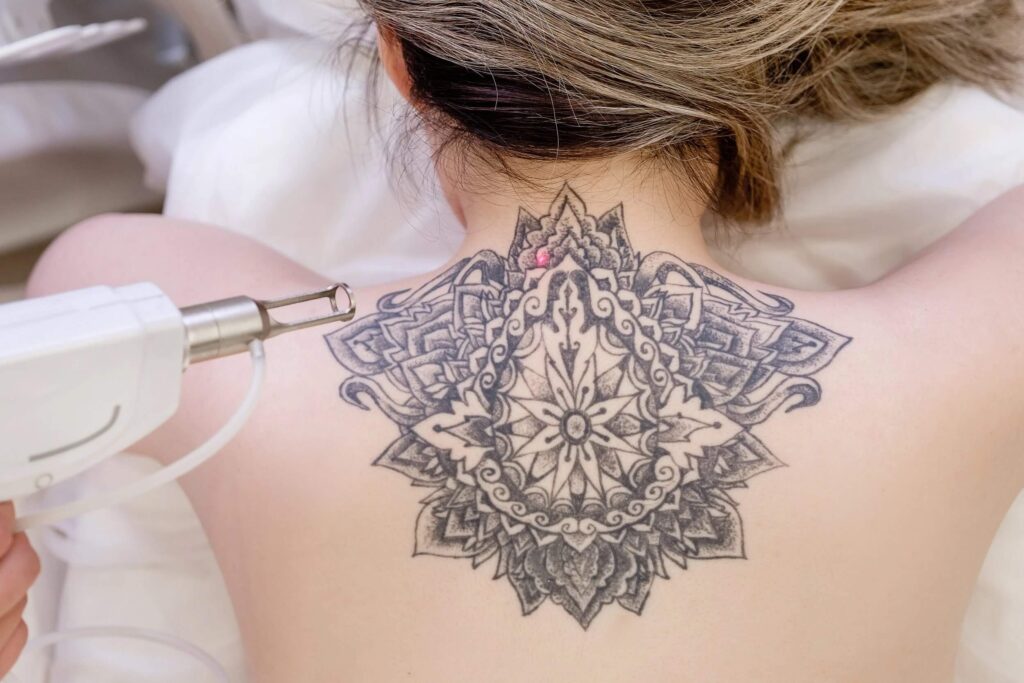Tattoo Removal

FROM ONLY £20
Laser Tattoo Removal
The desire to remove tattoos has always been counteracted by the resulting permanent scarring. This all changed thanks to the advent of the N Yag Q Switch laser technology (Quality factor – Switched laser) has it been possible to create systems for removing tattoos in an efficacious and non-invasive manner resulting in NO SCARRING.
How Laser Tattoo Removal Works
The N Yag Q Switch system releases high energy in extremely short times (max 6 ns), producing a “photo-acoustic” effect that breaks down the derma cells containing the tattoo pigment. Thanks to the rupturing of the membrane of these cells, the pigment is released and eliminated by the lymphatic-draining system. These short laser emissions allow for confining the thermal effect exclusively to the target to be hit – in this case the tattoo pigment – therefore safeguarding the surrounding tissues.
In order for the treatment to be effective, the laser light must be absorbed by the pigment. The colours of tattoos are often multiple and therefore one single session may not be sufficient for eliminating them all. Thanks to its dual wavelength the N Yag Q Switch, allows for removing numerous colours with one single system. By working in the infrared (1064 nm) black and blue tattoos can be removed even in dark photo-types thanks to the low interaction of this wavelength with the skin melanin. The green light (532 nm) instead acts on red or reddish colours. As with the removal of tattoos, only the Q-switched emission is capable of treating dermal lesions efficaciously without running the risk of scarring.
FAQs
frequently asked questions
In most cases the tattoo completely disappears. This result cannot always be achieved due to the diversity and different characteristics of the pigments, and therefore an intense fading effect is often obtained.
The procedure does not usually require an anesthetic. The effect of the laser is described as similar to the sharp ping of a rubber band on the skin. Some areas are more sensitive than others. In the case of particularly sensitive patients, a topical anesthetic can be applied before treatment.
The skin surface treated must be protected and medicated. An antibiotic cream is applied immediately after the operation and on the following days. There may be the formation of oedemas or small scabs. In this case it is important not to pick off or scratch the scabs to prevent any possible scarring or dyschromias. The lesion usually heals in 4 to 10 days. During the entire duration of the treatment it is important to keep the skin protected from the suns’ rays by using a total sun block.
- Redness and warmth at treatment site (COMMON)
- Blisters, crusting and swelling at treatment site (LESS COMMON)
- Burning and itching at treatment site (LESS COMMON)
- Post inflammatory pigmentation changes (RARE)
- Infection and scarring (VERY RARE)
As the laser beam selectively targets the pigment to be removed, safeguarding the surrounding skin, the possibility of scarring is very rare. In some cases, especially with dark photo types, there have been reports of hyper/hypo pigmentation, usually transitory, in the area treated. In order to restrict the onset of this, it is important to carefully follow the post-treatment instructions and avoid exposure to the sun.
The number of treatments will vary according to the type of tattoo, the colour, the depth and the density of the pigment, the anatomical site, and the age of the patient and the tattoo. Amateur tattoos usually respond better and are eliminated in from 1 to 4 sessions, spaced 4 weeks apart. More sessions are usually necessary for professional tattoos – on average 6 –10 – with 6 to 8 week intervals in between.
Starting from only £39 treatment is now an affordable option for everyone. Treatment costs vary depending on the area to be treated and the number of sessions required. Schedule a free personal consultation for more details.
The number of sessions required varies based on factors such as the size, color, and age of the tattoo, as well as the individual's skin type. Multiple sessions are usually needed, with several weeks between each session, to allow the body to eliminate the fragmented ink particles.
